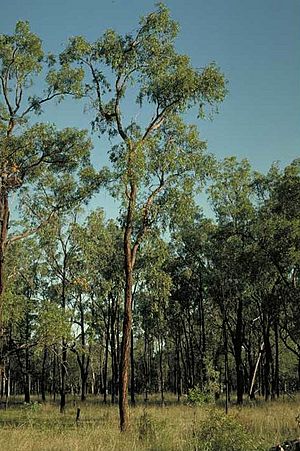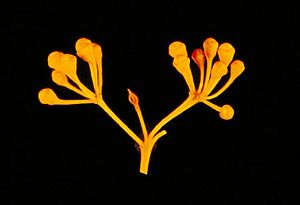Narrow-leaved white mahogany facts for kids
Quick facts for kids Narrow-leaved white mahogany |
|
|---|---|
 |
|
| Eucalyptus tenuipes near Bauhinia | |
| Scientific classification | |
| Genus: |
Eucalyptus
|
| Species: |
tenuipes
|
| Synonyms | |
|
|
The narrow-leaved white mahogany (Eucalyptus tenuipes) is a type of small tree that grows only in Queensland, Australia. It's known for its rough, fibrous bark and its long, narrow leaves. This tree produces white flowers and round fruits.
Contents
What Does the Narrow-leaved White Mahogany Look Like?
The narrow-leaved white mahogany is a tree that usually grows to be about 5–15 m (16–49 ft) (16 to 49 feet) tall. It has a special woody swelling at its base called a lignotuber. This helps the tree regrow if it gets damaged, for example, by fire.
Its trunk and branches are covered in rough, greyish-brown bark that feels like fibers. Young plants and new shoots (called coppice regrowth) have leaves that are directly attached to the stem (sessile). These leaves are paler underneath, long and narrow, measuring 70–155 mm (2.8–6.1 in) (2.8 to 6.1 inches) long and 4–12 mm (0.16–0.47 in) (0.16 to 0.47 inches) wide. They grow in pairs opposite each other.
Adult leaves also grow in opposite pairs. They are dull, dark green on top and much paler underneath. These leaves are narrow and shaped like a spear or an ellipse. They are 50–135 mm (2.0–5.3 in) (2 to 5.3 inches) long and 8–20 mm (0.31–0.79 in) (0.31 to 0.79 inches) wide. Each leaf tapers down to a stalk called a petiole, which is 4–15 mm (0.16–0.59 in) (0.16 to 0.59 inches) long.
Flowers and Fruit
The tree's flower buds grow at the ends of its small branches and where the leaves meet the stem (leaf axils). They appear in groups of eleven to twenty or more. These groups are on a thin, branching stalk called a peduncle, which is 3–15 mm (0.12–0.59 in) (0.12 to 0.59 inches) long. Each individual bud sits on its own small stalk, called a pedicel, measuring 6–15 mm (0.24–0.59 in) (0.24 to 0.59 inches) long.
When mature, the buds are round, pear-shaped, or oval. They are 3–4 mm (0.12–0.16 in) (0.12 to 0.16 inches) long and 2–3 mm (0.079–0.118 in) (0.079 to 0.12 inches) wide. Each bud has a cap-like structure called an operculum that is shaped like half a sphere. This tree has been seen flowering in January, March, May, and July, and its flowers are white.
After flowering, the tree produces a woody fruit. This fruit is a short, round, or half-sphere shaped capsule. It is 4–5 mm (0.16–0.20 in) (0.16 to 0.20 inches) long and wide, with its opening valves (parts that split open) near the rim.
How Did it Get its Name?
The scientific name of a plant helps scientists around the world know exactly which plant they are talking about. In 1928, two botanists, Joseph Maiden and William Blakely, first described this tree. They called it Eucalyptus acmenoides var. tenuipes in Maiden's book, A Critical Revision of the Genus Eucalyptus. They studied samples collected by Harald Ingemann Jensen near "Meteor Creek" in Queensland.
Later, in 1931, Blakely and Cyril Tenison White decided that this tree was unique enough to be its own species. So, they officially named it E. tenuipes in a scientific publication called Proceedings of the Royal Society of Queensland.
The second part of its scientific name, tenuipes, comes from Latin words. Tenui- means "slender" or "thin," and pes means "foot." This name refers to the thin stalks (pedicels) that hold the flower buds.
Where Does it Grow?
The narrow-leaved white mahogany grows in open forests. You can find it on gently sloping land between the towns of Rockhampton and St George in Queensland. It also appears sometimes further north.
Is it Protected?
Yes, this type of eucalypt is protected! The Queensland Government has classified Eucalyptus tenuipes as "least concern" under its Nature Conservation Act 1992. This means that while it's not currently endangered, its status is monitored to make sure it stays safe in the wild.


